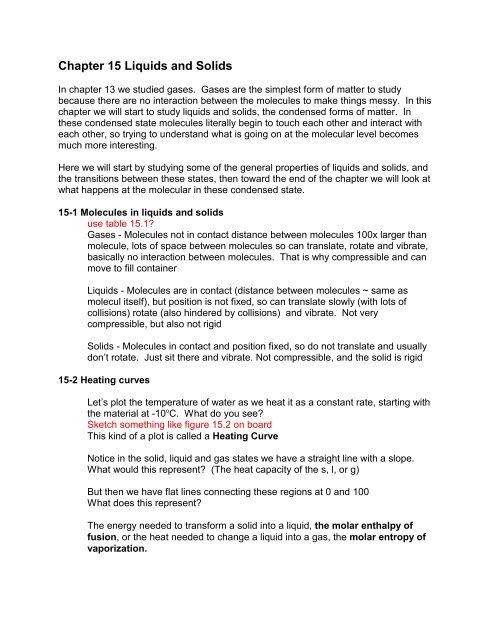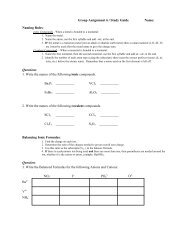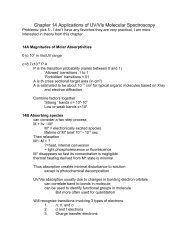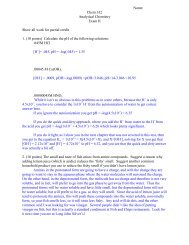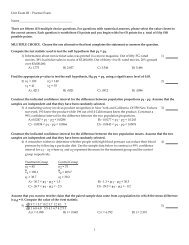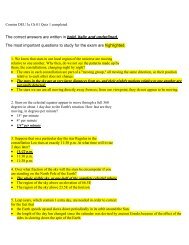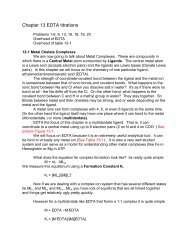Chapter 15 Liquids and Solids
Chapter 15 Liquids and Solids
Chapter 15 Liquids and Solids
Create successful ePaper yourself
Turn your PDF publications into a flip-book with our unique Google optimized e-Paper software.
<strong>Chapter</strong> <strong>15</strong> <strong>Liquids</strong> <strong>and</strong> <strong>Solids</strong>In chapter 13 we studied gases. Gases are the simplest form of matter to studybecause there are no interaction between the molecules to make things messy. In thischapter we will start to study liquids <strong>and</strong> solids, the condensed forms of matter. Inthese condensed state molecules literally begin to touch each other <strong>and</strong> interact witheach other, so trying to underst<strong>and</strong> what is going on at the molecular level becomesmuch more interesting.Here we will start by studying some of the general properties of liquids <strong>and</strong> solids, <strong>and</strong>the transitions between these states, then toward the end of the chapter we will look atwhat happens at the molecular in these condensed state.<strong>15</strong>-1 Molecules in liquids <strong>and</strong> solidsuse table <strong>15</strong>.1?Gases - Molecules not in contact distance between molecules 100x larger thanmolecule, lots of space between molecules so can translate, rotate <strong>and</strong> vibrate,basically no interaction between molecules. That is why compressible <strong>and</strong> canmove to fill container<strong>Liquids</strong> - Molecules are in contact (distance between molecules ~ same asmolecul itself), but position is not fixed, so can translate slowly (with lots ofcollisions) rotate (also hindered by collisions) <strong>and</strong> vibrate. Not verycompressible, but also not rigid<strong>Solids</strong> - Molecules in contact <strong>and</strong> position fixed, so do not translate <strong>and</strong> usuallydon’t rotate. Just sit there <strong>and</strong> vibrate. Not compressible, <strong>and</strong> the solid is rigid<strong>15</strong>-2 Heating curvesLet’s plot the temperature of water as we heat it as a constant rate, starting withothe material at -10 C. What do you see?Sketch something like figure <strong>15</strong>.2 on boardThis kind of a plot is called a Heating CurveNotice in the solid, liquid <strong>and</strong> gas states we have a straight line with a slope.What would this represent? (The heat capacity of the s, l, or g)But then we have flat lines connecting these regions at 0 <strong>and</strong> 100What does this represent?The energy needed to transform a solid into a liquid, the molar enthalpy offusion, or the heat needed to change a liquid into a gas, the molar entropy ofvaporization.
Key Definitions:Molar enthalpy of fusion ÄH fus = the heat energy required to change 1 mole ofsolid into a liquid at the melting point of that materialMolar enthalpy of vaporization ÄH vap = the heat energy required to change 1mole of liquid into a gas at the boiling point of that material<strong>15</strong>-3 Fusion <strong>and</strong> vaporizationThe enthalpy of fusion for water is:H O(s)H O(l) ÄH = 6.01 kJ/mol2 2 fusIn the general case we would writeX(s) X(l) ÄH fusThe heat needed to melts a material is thenq = nÄH fusWhat is going on here. There are intermolecular interactions that hold eachmolecule or atom in its place in the solid. The ÄH fusion represents the (+)energy added to the material to break just enough of these interactions that themolecules can begin to move around just enough to let the material as a wholebecome a liquid. We do not add enough energy to remove all intermolecularinteractions, otherwise we would go directly to the ga phaseThe enthalpy of vaporization for water is:H O(l)H O(g) ÄH = 40.65 kJ/mol2 2 vapIn the general case we would writeX(l) X(g) ÄH vapThe heat needed to melts a material is thenq = nÄH vapHere we are adding more energy to remove the last of the intermolecularinteractions that hold the molecules together. The ÄH vap represents the energyneeded to remove all these interactions so the molecules no longer have anyinteraction with each other, <strong>and</strong> the material becomes a gasIt is possible to go directly from a solid to a gas without going through a liquidphase. This process is called sublimationAgain we can define a ÄHsolid directly to a gassubwhich is the energy required to change one mole of2
If you have ever used dry ice (solid CO 2) you will have observed that the soliddisappears without a liquid phase. You may also have observed ice cubes inyour refrigerator getting smaller with time. The are both examples of sublimationSample calculationsoHow much energy is required to melt 50g of ice into water at 0 C?q=n ÄH fusn=50/18.02 = 2.77 moleq = 2.77 mol x 6.01 kJ/mol = 16.68 kJoHow much energy is required to take 50g of ice at -10 C <strong>and</strong> change it into wateroat 60 C?This is a little more interesting. You actually have three different stepsStep 1: ice @ -10 ice @ 0 use the heat capacity of H2O (s)Step 2: ice@0water @ 0 Use the ÄH fusionStep 3: water @ 0 water @ 60 use the heat capacity of H O (l)Since we are using 50 g of water in all three steps, let’s start withn=50/18.02 = 2.77 moleStep 1: q = n C P ÄTÄT = 0-(-10) = 10q 1 = 2.77 mol x 37.7 J/Kmole x 10 K=1044 J = 1.044 kJStep 2: q 2 =n ÄH fusn=50/18.02 = 2.77 moleq 2 = 2.77 mol x 6.01 kJ/mol = 16.68 kJStep 3: q 3 = n C P ÄTÄT = 60-(0) = 60q 3 = 2.77 mol x 75.3 J/Kmole x 60 K=12500 J = 12.5 kJq total = q 1 + q 2 + q3= 1.04 + 16.68 + 12.5 = 30.2 kJoHow much energy must be removed from 50 g of water at 60 C to change it tooice at -10 C?The reverse of the above process, so -30.2 kJ!Think about what you would have to do to take this same 50 of ices at -10 toochange it into steam at 400 C!23
4<strong>15</strong>-4 Intermolecular forcesThe value of ÄH vap or ÄH sub reflects how strongly the molecules are heldtogether in the liquid or solid. The larger the ÄH the stronger the forcesSo what are the forces holding molecules together? In this section will talk aboutthree different forces, Charge-charge electrostatic forces, Dipole-dipoleinteractions <strong>and</strong> hydrogen bonds, <strong>and</strong> London (of van der Waals) forcesI will tackle them in order from strongest to weakest.The strongest force is the charge-charge electrostatic interaction that wetalked about in chapter 6 when we discussed ionic compounds. The electricalforces between ions is strong an relatively long range, <strong>and</strong> this is reflected in thehigh ÄH vap of ionic compounds (100 kJ) <strong>and</strong> the high melting points <strong>and</strong> boilingpoints of ionic compounds when compared to other types of compoundsThe next strongest force is called the dipole-dipole interaction or dipoledipoleattraction. This is a force observed in molecules that contain a dipole(<strong>and</strong> this is why I tried to make sure you could identify this kind of molecule inchapter 7)While a molecule with a dipole had no net charge, so there is no charge-chargeinteraction, one end of the molecule has a partial positive charge compared tothe other end ( Make diagram of H2O on board) The partial charge + charge onone molecule is attracted to the slightly negative charge on the other end of asecond molecule, <strong>and</strong> this is what makes the intermolecular attraction betweenthe molecule.ÄH vap of polar molecules are typically ~ 10-20 kJ, making this interaction about10x weaker than the charge-charge interaction. They are also 10-20x weakerthan a typical bond energy, emphasizing the fact that intramolecular forces(between molecules) are much weaker than intermolecular forces (forces withinthe molecule)When you combine the small hydrogen atom with a strongly electronegativeatom like N, O or F, you get a particularly strong dipole-dipole interaction, towhich we give the special name hydrogen bond. Hydrogen bonds are 2-3 xstronger that regular dipole-dipole forces, <strong>and</strong> any compound that has Hattached to N, O, or F will have this extra strong attractive force.
It is this hydrogen bond that give water many of its special properties, like highmelting point <strong>and</strong> boiling point. It is also responsible for the relatively openstructure of ice, that breaks down on heating so liquid water can be denser thansolid water, just the opposite of what is seen in most solids that are more densthan their corresponding liquidsThe last intermolecular force that we observe is call the London force, <strong>and</strong> itoccurs in any molecule that has electrons (is all molecules) This force issometimes called an induced dipole-induced dipole interaction.Let’s use a couple of He atoms to illustrate how this force worksWith only 2 electrons in an He atom, <strong>and</strong> both of those electrons are wizzingaround in an orbital, through r<strong>and</strong>om chance the two electrons will be on oneside of the atom at one time. The, for a brief instant before the electrons moveon (at .01 the speed of light) , the molecule has a dipole. This dipole willinfluence the electrons in the neighboring He atom, so they will shift toward the +temporary dipole of the first atom, so you have induced a dipole in the secondatom. You now have a very brief dipole-dipole interaction that, very temporarilymake the two atoms attracted to each other(Make sketch like figure <strong>15</strong>.8 & <strong>15</strong>.9 on board)Because of there very fleeting nature, London interactions are very weak. Also,since one molecule has to be almost touching the second molecule to be able toinduce the dipole, the London forces are also very short range.Since you need electrons for a London force, the more electrons you have, thestronger the London force. So in general the larger a molecule or atom, thestronger the London force. Table <strong>15</strong>.4 See how He <strong>and</strong> Ne have ÄH vap 10 or100x smaller than dipole interaction (~10-20) but something like I 2 with good size<strong>and</strong> lots of electrons is about equivalent to a dipole interaction.Practice problems & clicker questionsRank the following atoms or molecules in order from largest to smallestintermolecular forces, <strong>and</strong> predict the relative MP <strong>and</strong> BP of these chemicals(Choose several)NaCl, MgS, LiF, CH2O CH2OH, H2O,Cl 2, Xe, CH 4 CH3-CH2-CH 3, CH3-O-CH3CF 4<strong>15</strong>-5 Properties of liquidsSeveral properties of liquids that depend on intermolecular forcesKey definition:Viscosity - a measure of the resistance to flow in a liquidCan be measured several ways, one is to simply see how fast a given volume ofliquid flows through a tube. Another is to drop on object in a liquid as see how5
fast it get to the bottom. Everyday example: 40w vs 5 w motor oil. Tied directly tointermolecular forces, the higher the forces, the higher the viscosity. Generallyobserved that at T v. Why? As T molecules move around more, as movearound more the intermolecular interactions so vKey Definition:Surface tension - a measure of the energy needed to increase the surface areaof a liquidWhat does that mean? Its pretty hard to explain. Lets start with ourintermolecular forces Sketch like <strong>15</strong>.13 on board When a molecule is in theinterior of a liquid, it has intermolecular forces all around it pulling it in alldirections. However when it is at the surface there is nothing to offset the forcestrying to drag the molecule back from the surface into the interior, so there is anet force taking all the molecules at the surface back into the bulk liquid.This force trying to make all the molecules at the surface move back into theliquid has the net effect of trying to make the surface area a minimum. You seethis with water drops <strong>and</strong> Hg dropsYou can either think of surface tension as a measure of this force, trying to dragthe molecules back into the bulk solvent, or you can think of it as a measure ofthe energy needed to increase the surface area as you distort it by placingsomething on it (Figure <strong>15</strong>.12)Again the higher the intermolecular forces, the higher the surface tensionYou can change the surface tension of a liquid by adding solutes that tend toaggregate on the surface <strong>and</strong> lower the surface tension. These king of materialsare called surfactantsDetergents are the most common example of a surfactant I can think of. How dothey work? If you have a greasy stain on your clothes <strong>and</strong> wash them with purewater, the water <strong>and</strong> the grease do not interact because they have differentintermolecular forces holding them together (See if you can figure out whichones!). In fact if you pour water on the grease spot you may even see the water‘bead up’ as it tries to minimize its contact with the grease. When you adddetergent, it lowers the surface tension of the water. One the water moleculesare not so strongly attracted to each other , they can penetrate into the greasemore easily <strong>and</strong> begin to dissolve the grease instead of avoiding it.Surface tension occurs at an interface because the intermolecular forces on theliquid side are not compensated for at the surface of the liquid. But whathappens at a liquid-solid interface, when the solid can do some of the sameinteractions as the liquid?6
7Key DefinitionCapillary action arises from the attraction of a liquid to a solid capillary tubeHere we now have to differentiate between the cohesive interactions holding theliquid together <strong>and</strong> the adhesive forces that may arise between the liquid <strong>and</strong>the solid. Both of these forces involve the intermolecular forces we are studyinghere.You have already observed capillary action 1000's of times in every day life.Why do paper towels absorb water? How can water rise in a plant without apump?The interplay between adhesive <strong>and</strong> cohesive forces at an interface is veryvisible in the meniscus of a liquid in a buret. Why does the meniscus curvedown when the buret is filled with water? Why does it curve up when it is filledHg?Let’s take our discussion of properties of liquids back to the forces that holdliquids together. What forces should we see in liquids?(Not charge-charge too strong, observed in solids)so that leaves dipole-dipole <strong>and</strong> LondonWhy do some liquids mix <strong>and</strong> some don’t? Why do some materials dissolve inwater, but not in gasoline? Polarity like-dissolves like. Again that is why I hadyou always determining the polarity of things back in chapter 6<strong>15</strong>-6 Vapor PressureNow let’s talk about what happens to a liquid as it vaporizesSketch like <strong>15</strong>.19 on boardTo become a vapor molecule, a molecule at the surface of a liquid must haveenough kinetic energy to break free of the surface <strong>and</strong> go into the gas phase.As you learned in the chapter 13, at any temperature the molecules of asubstance have a range of kinetic energies. So at a particular temperature acertain % of molecules will have enough KE to go into the vapor phase.Initially, with no molecules in the vapor phase the partial pressure of the liquid inthe gas rises quickly (figure <strong>15</strong>.20 on board) but as more an more molecules getinto the vapor phase, some of those molecules r<strong>and</strong>omly hit the surface of theliquid <strong>and</strong> return to the liquid phase. At some point the rate of moleculesentering the gas phase = rate of molecules returning to liquid phase(condensing) <strong>and</strong> you reach what is called the equilibrium vapor pressure
8Key definition:The equilibrium vapor pressure is the partial pressure of a gas that is inequilibrium with its liquid at a specific temperature.Another thing you learned in chapter 13 was that at the temperature increases,the average kinetic energy of the molecules in a sample increases, so thenumber of molecules entering the vapor phase will increase. Thus theequilibrium vapor pressure is a function of temperature, <strong>and</strong> as T, VPFigure like <strong>15</strong>.23 on boardThe plot of VP on the Y <strong>and</strong> T on the X axis is called a vapor pressure curve.As you can see different liquids have difference vapor pressure curves, <strong>and</strong> thecurve seems to rise exponentially. In chapter 23 we will come up with amathematical model for this curve, but for now we won’t go into the math indepth.<strong>Liquids</strong> or solids that have a high vapor pressure are called volatile <strong>and</strong> haverelatively low intermolecular forces, ones with low vapor pressure are called nonvolatile<strong>and</strong> have higher intermolecular forcesOn figure <strong>15</strong>.23, what is the significance of the line at 760 torr?760 torr is the atmospheric pressure. When the vapor pressure of a liquid isabove this value the gas can readily form bubbles <strong>and</strong> leave the liquid becauseits pressure is at or above the air around the liquid. When the VP is below this,the pressure of the air prevents bubble from forming <strong>and</strong> the liquid doesn’t formbubblesThis is the way we define the boiling point of a liquidKey Definition:The normal boiling point of a liquid is the temperature at which the vaporpressure of a liquid is equal to 1 atm.oWhile the normal boiling point of water is 100 C, what is the BP here inSpearfish? The atmospheric pressure in Spearfish is generally around .88 atm,so when you boil water the vapor pressure of the water matches the externalpressure at a lower temperature so the water begins to boil earlier, about 96 o C
9Sample calculation using table <strong>15</strong>.7I am going to put .1000 g of water in a 1L flask, <strong>and</strong> seal it so no water canoescape. If I heat the flask to 50 C will any liquid be left in the container?PV=nRTP = nRT/VT = 273 + 50 = 323Kn = 1g x 1 mole = .0556 mole18 gP =( .0556 mole x .08206 Latm/Kmol x 323K )/1L = .148 atmoThe vapor pressure of water at 50 C is .122 atmSince our theoretical pressure is higher than it should be, liquid water willcondense until the VP in the container = .148How much will condense?oIf the VP or water at 50 C is .122, then the most water that can be in 1 liter ofgas is:PV=nRTn=PV/RT= (.122 atm x 1L)/(.08206 Latm/Kmol x 323K)=.0046 mole.0046 moles x 18 g/mole = .0826 grams of water in the vapor phase.1 - .0826 = .018 g liquid water remains<strong>15</strong>-7 Relative HumidityNow that you know what vapor pressure is, you can underst<strong>and</strong> what relativehumidity <strong>and</strong> dew point are. However we don’t worry too much about theseparameters relative in the chem lab, so I think I will skip this section. Feel free toread it if you are interested.<strong>15</strong>-8 Phase DiagramsYou just examined the vapor pressure curve, you can do a similar curve to plotwhen a solid <strong>and</strong> a gas are in equilibrium (Sublimation curve) or solid <strong>and</strong> liquidare in equilibrium (melting point curve)Rather than having 3 separate curves, we can put them into a single diagramcalled a phase diagram Figure <strong>15</strong>.24 or on board. Point out the three differentcurves, work your way from solid to liquid to gas at 1 ATM. Also point out thebreaks on both the X <strong>and</strong> Y axisLet’s look at some of the more interesting pieces of this diagram
10The Critical PointLet’s start with the upper right h<strong>and</strong> end of the vapor pressure curve. Ratherthan going up <strong>and</strong> to the right forever, the line actually has a well definedstopping point, call the critical pointWhat is happening here is that you reach a temperature above which the gascannot be changed into a liquid <strong>and</strong> the liquid <strong>and</strong> the gas becomeindistinguishable. The state is called a supercritical fluid (More on this in a bit)Key definitions:Critical temperature - the temperature above which a gas cannot be compressedinto a liquid, bot matter how high you make the pressure.Critical Pressure - The pressure required to liquify a gas at its critical temperatureMelting point curveAt a given pressure, if you are colder than the line you have a solid if you arewarmer than the line, you are a liquid. If you are right on the line you have anequilibrium between solid <strong>and</strong> liquid so you solid is trying to melt <strong>and</strong> you haveslushKey Definition:The temperature at which solid <strong>and</strong> liquids are in equilibrium <strong>and</strong> the totalpressure is 1 atm is called the normal melting point or normal freezing point.It is hard to see in this figure, but water’s melting point curve is a little unusual inthat it has a negative slope. We discussed earlier about how solid water is lessdense than liquid water. Thus when you are near this melting curve in the solidform, <strong>and</strong> you apply pressure to compress water, it shifts to it’s denser form, theliquid. Not many materials do thisSublimation curveThe sublimation curve is where the solid can go directly to gas. This is howfreeze-drying works. If you take anything that contains water <strong>and</strong> cool it belowo273.16K (~0 C) , <strong>and</strong> reduce the pressure to < .006 atm, the solid can sublimedirectly to a gas, <strong>and</strong> you can remove the remove the water!Triple pointNotice there is one point on this diagram where all three phases can coexist atone temperature <strong>and</strong> pressure. This point is called the triple pointKey Definition:The triple point is the point at which three phases can coexist at one temperature<strong>and</strong> pressure
For contrast let’s look at the phase diagram for CO 2 Figure <strong>15</strong>.25This has a more normal + slope (Again hard to see in this figure)at 1 atm transition from solid to gas occurs at -78, so what is the temp ofsomething you just pulled out of dry ice? (-78)ooTriple point 5.1 atm, -56.6 C, critical point at 72.8 atm 31 CMany fire extinguishers contain CO 2. If they contain liquid CO 2 what would theinternal pressure have to be?(close to 70 atm)When release liquid goes to gas, cools off fast. The white fog is actually waterNOT CO 2! CO 2 is also heavier than air so settles (Should CO 2 be heavier thanair? How can tell (Air is mostly N 2; N 2 has MW of 28, CO 2 has a MW of12+16+16= 44)Another practical application. We just talked about the critical point. When youget a fluid up into this region between liquid <strong>and</strong> gas you have what is called asuper-critical fluid. This may sound like some exotic came talk, but it has veryday-to-day applications. How do you decaffeinate coffee? One way is to extractwith thing like chloroform, or CH2Cl 2 (dichloromethane). Not very appetizing.Another way is with supercritical CO 2! In fact this is how the bulk ofdecaffeinated coffee is produced. Put it in the CO 2 at high pressure <strong>and</strong> RT <strong>and</strong>the caffeine leaches out of the coffee bean. Drop the pressure <strong>and</strong> , boil off theCO 2 <strong>and</strong> you bean is decaffeinated! What do you do with the caffeine you haveleft? You sell it to the people making soft-drinks!11Caffeine
12Practice problems <strong>and</strong>/or clicker questionsUsing the phase diagram for C, pick out the triple point, critical point etc.<strong>15</strong>-9 Crystal StructuresWe will now turn our attention to solids.<strong>Solids</strong> are usually broken down into two groups, crystalline <strong>and</strong> noncrystalline.We will start our discussion with crystalline solids because they have a regular,repeating structure that is easy to underst<strong>and</strong>. We will end the chapter with briefdiscussion of a couple of forms of noncrystalline solids, amorphous solids <strong>and</strong>liquids crystalsCrystalline solidsThe distinguishing feature of a crystalline solid is that it has a regular repeatingstructure, a structure we call the crystal lattice.This regular repeating structure allows us to use diffraction to probe <strong>and</strong> identitythe underlying repeating structure.This text does not go into much depth on how diffraction works, so let me add alittle extra materialX-ray Analysis of <strong>Solids</strong>How do we know that the crystals have the structure they do?Found by X-ray diffraction, that is shine X-ray light at the crystal <strong>and</strong> see how itbounces off. Look at figure 10.10 Zumdahl`.The whole idea is based on constructive <strong>and</strong> destructive interference. Let’s sit atangle theta with respect to our crystal plane. Notice in case 1 the wave formsgoing to the second atom travel exactly two wavelength more. What happens ifthe distance between the atoms is different or the angle is different? Wave outof phase, <strong>and</strong> cancel out.Without getting into the math, which is elementary geometry if you want to thinkabout it we have the relationshipKey Equation:në = 2dsin èThis is called the Bragg equation.Essentially what we do is to shine X-rays at a crystal then look for all the angleplaces where X-rays appear around it. Can reconstruct distances betweenatoms form this.
Practice Problem:If you use an X-ray with a 1.54 wavelength to examine a sample of silicon <strong>and</strong>oobserve an angle of 14.22 for the first order reflection (n=1), what is the distancebetween layers in the silicon crystal?1(1.54) =2d sin(14.22 o )1.54 = 2d(.2456)1.54/(2X.2456) =d; d=3.13The Crystal LatticeFigure <strong>15</strong>.28The smallest subunit of a crystal lattice that can be repeated over <strong>and</strong> over tomake the entire crystal is called the unit cell.There are a wide variety of 3-D units cells, but here we will only discuss the cubicunit cell, because that is the one that is sen in most metallic elementsFigure <strong>15</strong>.29There are three different kinds of cubic unit cells, the simple cubic cell, whichhas an atom at each cornet of the cube, a body-centered cubic unit cell, thathas an additional atom in the very center of the cube, <strong>and</strong> a face-centeredcubic unit cell that has the atom at each corner <strong>and</strong> an atom in the center ofeach face of the cell.Let’s look a little more closely at each. Notice that is the simple cubic unit cell,each atom is at a corner of the cell, <strong>and</strong> only 1/8 of that atom is actually in thecell With 8 corners <strong>and</strong> 1/8 of an atom in the cell. Taht make a total of 1 atoms/cellInterestingly, of all the metals, only polonium uses this type of unit cellWith the body-centered unit cell, we have 8 x 1/8 corner atoms + the one in themiddle, so we have 2 atoms/unit cell. Metals that use this type of unit cellinclude Ba, Cs, K, LI, Mo, Ta, U, & VIn the face-centered cell we have 8 x 1/8 + 6x1/2 for a total of 4 atoms/unit cell.Metals that use this lattice include Ag, Au, Cu, Ni, Pb,Sr, Pt, & the noble gases.13CalculationsThere is an equation I want you to be able to use, <strong>and</strong> it is fairly simple to deriveYou know that density = mass /volumeNow lets substitute in the molar mass <strong>and</strong> the molar volumedensity = M/V ; M = molar mass, V = molar volumemolmol
14Let’s get V mol on one side of the equationV mol = M/densityThe volume of one atom = molar volume/NaVolume of 1 atom = V /N = M/(density × N )mol A AAnd if the unit cell has n atoms, the volume of atoms in the unit cell is(n M) /(Density ×N )Key Equation:AUsing this equation you can go in lots of different directions.Example problem 1Cu crystallizes in a face centered cubic lattice <strong>and</strong> has a density of 8.96 g/cm 3Calculate the volume of the Cu unit cell.A face centered cubic lattice had 4 atoms in the unit cell so n=43 23V atoms in unit cell = (4atoms/cell x63.55g/mol)/(8.96 g/cm x 6.022x10 atoms/mole)23 3= 4.71 x10 cm /cellGetting to the actual volume of the atom is a bit trickier, <strong>and</strong> involvesremembering some basic geometry. I don’t think I will do this to you on a test solet’s not go that far. You can see how to do it in your text if you are reallyinterested.Example 2Cerium crystallizes in a face-centered cubic lattice. Given that the density of3Cerium is 6.770 g/cm , <strong>and</strong> the length of an edge of the units cell is 516.10 pmdetermine Avogadro’s numberVolume of unit cell = (n M) /(Density ×N A)Rearranging this equation to find N AN = (nM)/(Density x Volume of unit cell)Aif the length of an edge of the unit cell is 516.10 pm the volume of the unit cell is(516.10 pm) 3
<strong>15</strong>Let’s convert that to cm-12 -101 pm x 1x10 m x 1cm = 1x10 cm1 pm 1x10 -2-10 -8516.10 pm x 1x10 cm = 5.1610x10 cmpm-8 3 -22 3Volume of unit cell = (5.1610x10 cm) = 1.37458 x10 cmn, the number of atoms in the face centered unit cell is 4soN A = (nM)/(Density x Volume of unit cell)3 -22 3=(4x140.116)/(6.770 g/cm x 1.37458 x10 cm )23=6.0227x10 Sounds familiar!<strong>15</strong>-10 Crystal ForcesCrystal structures determined by:size of atom, ion, or molecule making up latticetype of forces used to hold crystal togetherIonic CrystalsStrong Charge-charge interactions holding lattice togetherhave ions at lattice pointsHigh MP, low BPRelative size of ions determined lattice usedFigure <strong>15</strong>.30(Cl>Na) NaCl Chloride is face centered cubic(Cl
Amorphous solids - not crystallineno precise crystal structuredo not melt at a single sharp temperatureUsually soften over a wide range of TCan think of like liquids that froze to fact to make proper oriented crystalsRubber, plastic, glass16<strong>15</strong>-11 Electrons in MetalsMetallic Crystalline solidsBonding between atoms in metals is something novelFigure like <strong>15</strong>.35 on boardWhen made a molecular orbital from 2 atomic orbital in nonmetalshad big separation between bonding <strong>and</strong> nonbonding orbitalsIn metal crystal have many more metalshave a wide b<strong>and</strong> of many bonding <strong>and</strong> non-bonding orbitalsFigure like <strong>15</strong>.35,<strong>15</strong>.36, <strong>and</strong> <strong>15</strong>.37Nonbonding orbitals are the conduction b<strong>and</strong>,Bonding orbital make the valence b<strong>and</strong>Lots of orbital <strong>and</strong> very little gap in between can move electrons aroundeasilyCall metallic covalent bond or delocalized covalent bondAllow metals to move around, conduct heat <strong>and</strong> electricityAlso explains why nonmetals don’t conduct<strong>and</strong> starts to explain semiconductors (with small bad gap)<strong>15</strong>-12 Liquid CrystalsSo we have studied crystals, what is a liquid crystal?Figure <strong>15</strong>.39Liquid crystal has properties of both liquid <strong>and</strong> crystal.Illustrate with rodlike, hydrophobic moleculesLike to use london force to align side by sidecan get Smectic phase where have layersor Nematic phase where layers disappearso have phase transition between the two
17<strong>15</strong>-13 ColloidsIn a solution, every individual atom or molecule of the solute is completelydispersed in the solvent.In a suspension you have visible (you may have to use a microscope) particlesdispersed in a solvent <strong>and</strong>, given enough time, the particles will settle to thebottom.In between we have colloids or colloid dispersionsparticles are too small to bee seen, even with a microscopeBut are not individual atoms or moleculeswill not settle to the bottomNot an ‘official’ state of matter like s,l,g but still has special propertiesparticle size ~ 1-1000 nm (~ size of starch, proteins, DNA)With such small size, particles have very large surface area <strong>and</strong> if surface isattracted to solvent, that is what will keep particle suspended indefinitelyA little bit of nomenclatureDispersed phase - the particles that are dispersedDispersion medium - the medium in which they are dispersedJust like solutions are not all aqueous, but can include gases <strong>and</strong> solids,dispersions can have several different phases.See table <strong>15</strong>.9 for the proper name of each kind of dispersionOne kind of dispersion that plays an important role in everyday life is anemulsion. As you can see an emulsion is a dispersion of a liquid in a liquid.Mayonnaise is an emulsion of the fats <strong>and</strong> oils of egg yolk in water. Emulsionsof oils <strong>and</strong> water are usually not stable, unless a detergent is present. On themolecular level soaps <strong>and</strong> detergents are large hydrophobic molecules with acharged or polar end. As shown in figure <strong>15</strong>.43 the oil water emuslion is madeup of thous<strong>and</strong>s of tiny micelles where the detergent essentially forms aninterface between the hydrophobic oil <strong>and</strong> the hydrophillic water. It is thisinterface that keeps the emulsion stable. You will see this same kind of structureover <strong>and</strong> over again in biochemistry in the structure of proteins, membranes,cells, <strong>and</strong> even DNA itself.How do you tell experimentally if you have a colloidal solution? The dispersedparticles will scatter light much differently that a true solution. The scattering oflight by a dispersion is called the Tyndall effect. Demo with laser <strong>and</strong> starch


